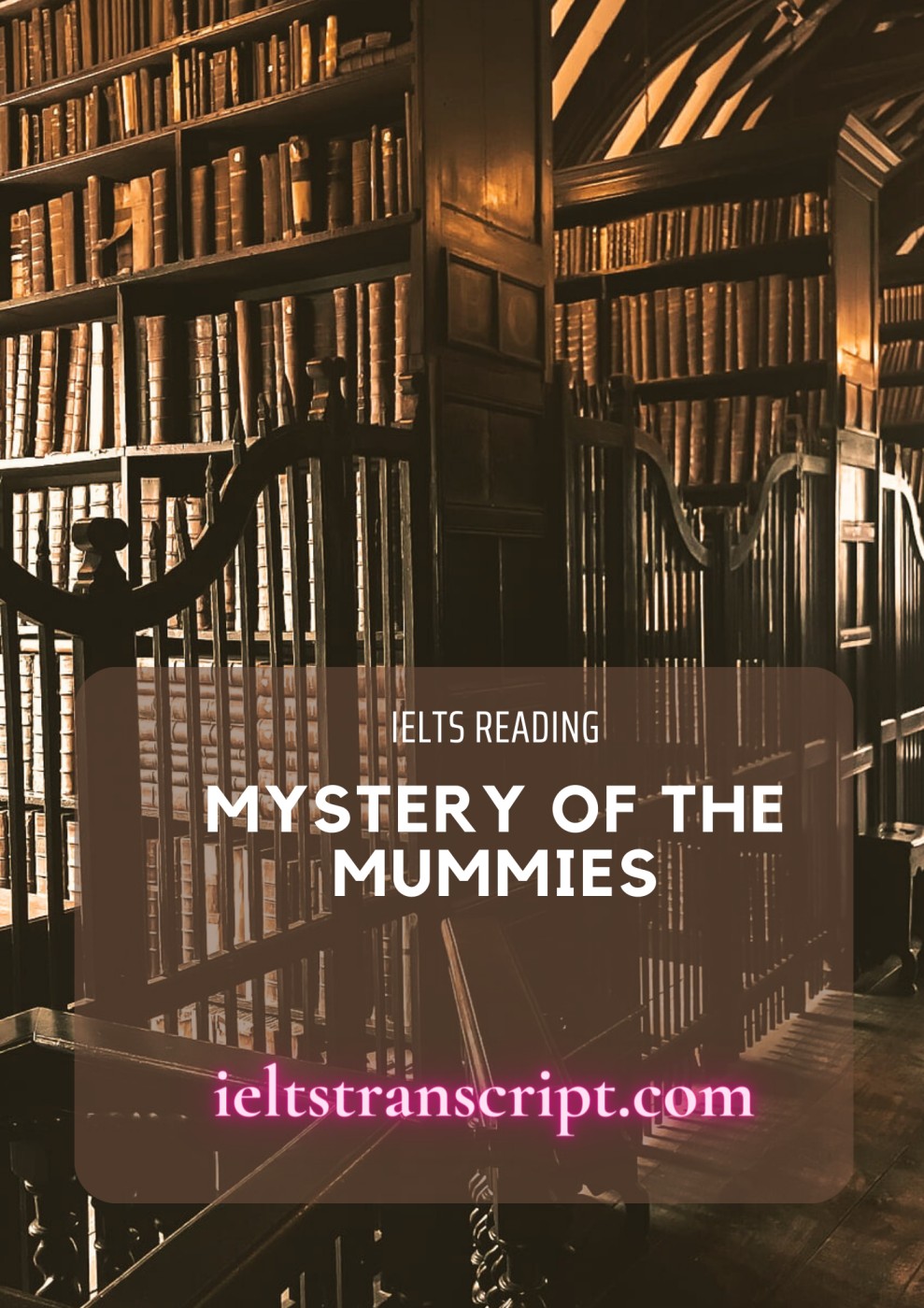- Đối với sản phẩm có giá: Sau khi chúng tôi ghi nhận thông tin đã thanh toán sản phẩm của bạn, sản phẩm sẽ được mở khóa và bạn có thể xem trực tiếp và tải tài liệu sản phẩm.
- Đối với thành viên trả phí: Bạn có thể mua và thanh toán sản phẩm với giá 0đ để tải tài liệu sản phẩm.
- Bạn có thể liên hệ với chúng tôi để được hỗ trợ mở khóa sản phẩm sớm nhất.
Mystery of the mummies
- Chúng tôi chấp nhận các phương thức thanh toán sau đây: Thẻ tín dụng, thẻ ghi nợ, PayPal, chuyển khoản ngân hàng và tiền mặt.
Chúng tôi sẽ không thu thêm phí cho bất kỳ hình thức thanh toán nào.
- Nếu bạn gặp vấn đề về sản phẩm của chúng tôi trong thời gian sử dụng, vui lòng liên hệ với chúng tôi để được hỗ trợ xử lý sớm nhất nhé.
Xem trước mẫu
Mystery of the mummies
In 1992, a German scientist made a discovery which was to upset whole areas of scientific study from history and archaeology to chemistry and botany. Dr. Svetlana Balabanova, a forensic specialist, was performing tissue tests on an Egyptian mummy, part of a German museum collection. The mummified remains were of a woman named Henut-Taui who had died over 3,000 years ago. Amazingly, the tests revealed that her body contained large quantities of cocaine and nicotine. Dr. Balabanova had regularly used the same testing methods to convict people of drug consumption but she had not expected to find nicotine and cocaine in an Ancient Egyptian mummy. It is generally accepted that these two plants, native to the Americas, did not exist on other continents prior to European exploration.
Dr. Balabanova repeated the tests then sent out fresh samples to three other labs. When the results came back positive, she published a paper with two other scientists. If Balabanova was shocked by the results of her tests, she was even more shocked at the hostile response to her publication. She received many insulting letters, accusing her of fraud.
There were two explanations that came immediately to mind. One was that something in the tests could have given a false result. The second was that the mummies tested were not truly Ancient Egyptian. Perhaps they were relatively modern bodies, containing traces of cocaine. Dr. Balabanova then examined tissue from 134 naturally preserved bodies over a thousand years old discovered in an excavated cemetery in the Sudan. About a third of them tested positive for nicotine or cocaine.
But something had happened even earlier which should have initiated serious discussion. In 1976, the mummified remains of Ramses II arrived in Paris for repair work. Dr. Michelle Lescot of the Natural History Museum (Paris) was looking at sections of bandages and within the fibres found a plant fragment. When she checked it under a microscope, she was amazed to discover that the plant was tobacco. Fearing that she had made some mistake, she repeated her tests again and again with the same result every time: a New World plant had been found on an Old World mummy. The results caused a sensation in Europe. Was it possible that a piece of tobacco had been dropped by chance from the pipe of some forgotten archaeologist? Dr. Lescot responded to this charge of contamination by carefully extracting new samples from the abdomen, with the entire process recorded on film. These samples, which could not be ‘droppings’, were then tested. Once again they were shown to be tobacco. The discovery of tobacco fragments in the mummified body of Ramses II should have had a profound influence upon our whole understanding of the relationship between Ancient Egypt and America but this piece of evidence was simply ignored. It raised too many questions and was too far outside of commonly accepted scientific views.
So now the question had returned. Could Ancient Egyptian trade have stretched all the way across the Atlantic Ocean? This was an idea so unbelievable it could only be considered after all other possibilities had been eliminated. Could Egyptians have obtained imports from a place thousands of miles away, from a continent supposedly not discovered until thousands of years later? Was it possible that coca – a plant from South America – had found its way to Egypt 3,000 years ago? If the cocaine found in mummies could not be explained by contamination, or fake mummies or by Egyptian plants containing it, there appeared to be another interesting possibility: a trade route with links all the way to the Americas.
The Egyptians did make great efforts to obtain incense and other valuable plants used in religious ceremonies and herbal medicines, but to the majority of archaeologists, the idea is hardly worth talking about. Professor John Baines, an Egyptologist from Oxford University, states: ‘I don’t think it is at all likely that
...Bí ẩn của những xác ướp
Năm 1992, một nhà khoa học người Đức đã có một khám phá làm đảo lộn toàn bộ các lĩnh vực nghiên cứu khoa học từ lịch sử, khảo cổ học đến hóa học và thực vật học. Tiến sĩ Svetlana Balabanova, một chuyên gia pháp y, đã thực hiện các khám nghiệm về mô trên một xác ướp Ai Cập, một phần trong bộ sưu tập của bảo tàng Đức. Xác ướp thuộc về một người phụ nữ tên là Henut-Taui đã chết cách đây hơn 3.000 năm. Thật đáng kinh ngạc khi các cuộc kiểm tra cho thấy cơ thể cô chứa một lượng lớn cocaine và nicotine. Tiến sĩ Balabanova đã thường xuyên sử dụng các phương pháp khám nghiệm tương tự để kết tội những kẻ tiêu thụ ma túy nhưng cô không ngờ rằng lại tìm thấy nicotine và cocaine trong một xác ướp Ai Cập cổ đại. Người ta đã luôn nghĩ rằng hai loài cây này, có nguồn gốc từ châu Mỹ, không tồn tại ở các lục địa khác trước khi diễn ra các cuộc thám hiểm của người châu Âu.
Tiến sĩ Balabanova lặp lại các xét nghiệm sau đó gửi các mẫu mới đến ba phòng thí nghiệm khác. Khi kết quả nhận về là dương tính, cô đã xuất bản một bài báo cùng với hai nhà khoa học khác. Nếu như Balabanova đã từng bị sốc trước kết quả xét nghiệm của mình, thì cô ấy còn bị sốc hơn trước phản ứng thù địch đối với công bố của mình. Cô nhận được nhiều lá thư xúc phạm, buộc tội cô lừa đảo.
Có hai cách giải thích được nghĩ đến trước tiên. Thứ nhất là điều gì đó trong các xét nghiệm có thể đã dẫn tới một kết quả sai. Thứ hai là các xác ướp được xét nghiệm không phải là người Ai Cập cổ đại thực sự. Có thể chúng là những thi thể khá gần thời hiện đại, có chứa dấu vết của cocaine. Tiến sĩ Balabanova sau đó đã khám nghiệm mô từ 134 thi thể được bảo quản tự nhiên hơn một nghìn năm tuổi được phát hiện trong một nghĩa trang khai quật ở Sudan. Khoảng một phần ba trong số đó có kết quả dương tính với nicotine hoặc cocaine.
Tuy vậy, một điều đã xảy ra thậm chí còn sớm hơn lẽ ra đã phải khơi mào các cuộc thảo luận nghiêm túc. Năm 1976, xác ướp của Ramses II được đưa đến Paris để phục chế. Tiến sĩ Michelle Lescot của Bảo tàng Lịch sử Tự nhiên (Paris) trong khi xem xét các đoạn băng quấn và bên trong các mảnh sợi đã tìm thấy một mẩu cây. Khi kiểm tra dưới kính hiển vi, cô đã vô cùng kinh ngạc khi phát hiện ra rằng đó là cây thuốc lá. Lo sợ rằng mình đã mắc phải sai lầm nào đó, cô lặp đi lặp lại các xét nghiệm của mình nhiều lần với cùng một kết quả thu được: một loài thực vật của Thế giới mới đã được tìm thấy trên xác ướp từ Thế giới cũ. Kết quả này đã gây ra một cơn chấn động ở châu Âu. Có khả năng là một mẩu thuốc lá đã tình cờ rơi ra từ tẩu thuốc của một nhà khảo cổ học bị lãng quên nào đó? Tiến sĩ Lescot đã phản ứng với cáo buộc do nguyên nhân nhiễm bẩn này bằng cách cẩn thận trích xuất các mẫu mới từ vùng bụng, với toàn bộ quá trình được ghi hình lại. Những mẫu này, không thể là ‘bị đánh rơi vào’, sau đó đã được đem kiểm tra. Một lần nữa chúng được cho thấy là thuốc lá. Việc phát hiện ra các mẩu thuốc lá trong xác ướp của Ramses II lẽ ra đã phải có ảnh hưởng sâu sắc đến toàn bộ hiểu biết của chúng ta về mối quan hệ giữa Ai Cập cổ đại và châu Mỹ nhưng bằng chứng này đã bị phớt lờ. Chúng đặt ra quá nhiều câu hỏi và đi quá xa so với các quan điểm khoa học được chấp nhận phổ biến.
Và giờ đây câu hỏi đó đã quay trở lại. Có thể ngành thương mại của người Ai Cập cổ đại đã vươn tới khắp Đại Tây Dương? Đây là một ý tưởng khó tin đến nỗi nó chỉ có thể được xem xét sau khi tất cả các khả năng khác đã bị loại bỏ. Liệu người Ai Cập có thể lấy được những món đồ từ một nơi cách xa hàng nghìn dặm, từ một lục địa bị coi là chưa được phát hiện cho đến hàng nghìn năm sau? Liệu có khả năng coca – một loại cây từ Nam Mỹ – đã tìm đường đến Ai Cập từ cách đây 3.000 năm? Nếu cocaine được tìm thấy trong xác ướp không thể giải thích được là do bị nhiễm bẩn, hoặc xác ướp giả hoặc do thực vật từ Ai Cập chứa nó, thì dường như có một khả năng thú vị khác: một tuyến đường thương mại kết nối đến châu Mỹ.
Người Ai Cập đã dành rất nhiều nỗ lực để thu được hương trầm và các loại cây có giá trị khác
...Để xem được đầy đủ nội dung và tải dữ liệu, bạn phải trở thành thành viên của chúng tôi và trả phí cho tài liệu (nếu có)











